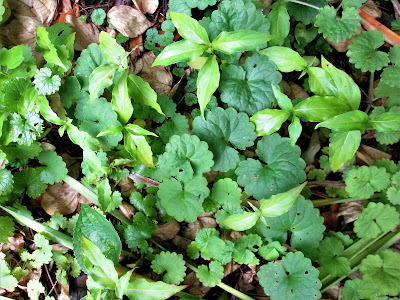So asked the poet Sara Teasdale in her 1915 poem, "Spring Night," and while the speaker in the poem never answers her own question, I would have to say "No." Of course, the sorrowful young woman in the poem is moping about because of her lack of a love interest, while I am complaining about a physically lovely plant that is verging on becoming an invasive in our yard.
I refer to the Asian kousa dogwood, widely planted in the US because of its resistance to the anthracnose that plagues our native Cornus florida. This small tree is definitely a beauty, blooming several weeks after its cousin and possibly for a longer period.
But.
The areas underneath our trees are liberally sprinkled with baby kousas every year. Sometimes they hide behind other plants, and are a foot or more tall before I notice them. When we moved in, several years after the decline and death of the home's previous inhabitant, the walled garden near the house was home to two volunteer kousas nearly as tall as I. But free trees are a good thing, right?
Not always, and not in this case. One reason for Cornus kousa's "success" in North American landscapes is that it is not particularly attractive to North American wildlife. Pileated woodpeckers have been reported to feed on the strawberry-sized fruit, and I have seen squirrels nibbling on them, but this Asian dogwood's fruits are too big for most songbirds. The much smaller berries of our native dogwoods are more suited to our birds, which did, after all, co-evolve with them.
The real problem with this tree, though, is that it feeds zero caterpillar species, and caterpillars are essential to most terrestrial food webs. Nearly all songbirds feed their young a diet composed mostly of lepidoptera larvae, so no larvae=no baby birds. In ecosystem terms, kousa is not only invasive but basically useless. In contrast, Cornus florida, the common eastern dogwood, supports 117(!) moth and butterfly species, which in turn support birds and other wildlife. Deciding which tree to plant should be pretty much a no-brainer.
Beauty is absolutely not enough.



2 comments:
Love you blog posts as I always learn so much. We just removed a dogwood from the front yard, I think the voles did it in, or maybe the heavy snow that cracked so many branches. So I am trying to be mindful about replacement. I think I will go up to the family farm and dig a dogwood out of the woods. Maybe put it in the backyard this time, and once the stump is ground out in the front, continue on my journey of putting natives perennials out there. Honestly, I could plant every inch of my yard in butterfly weed and be perfectly happy with that.
Butterfly weed is great! Mountain mint is also a pollinator magnet and thrives in the same conditions.
Post a Comment